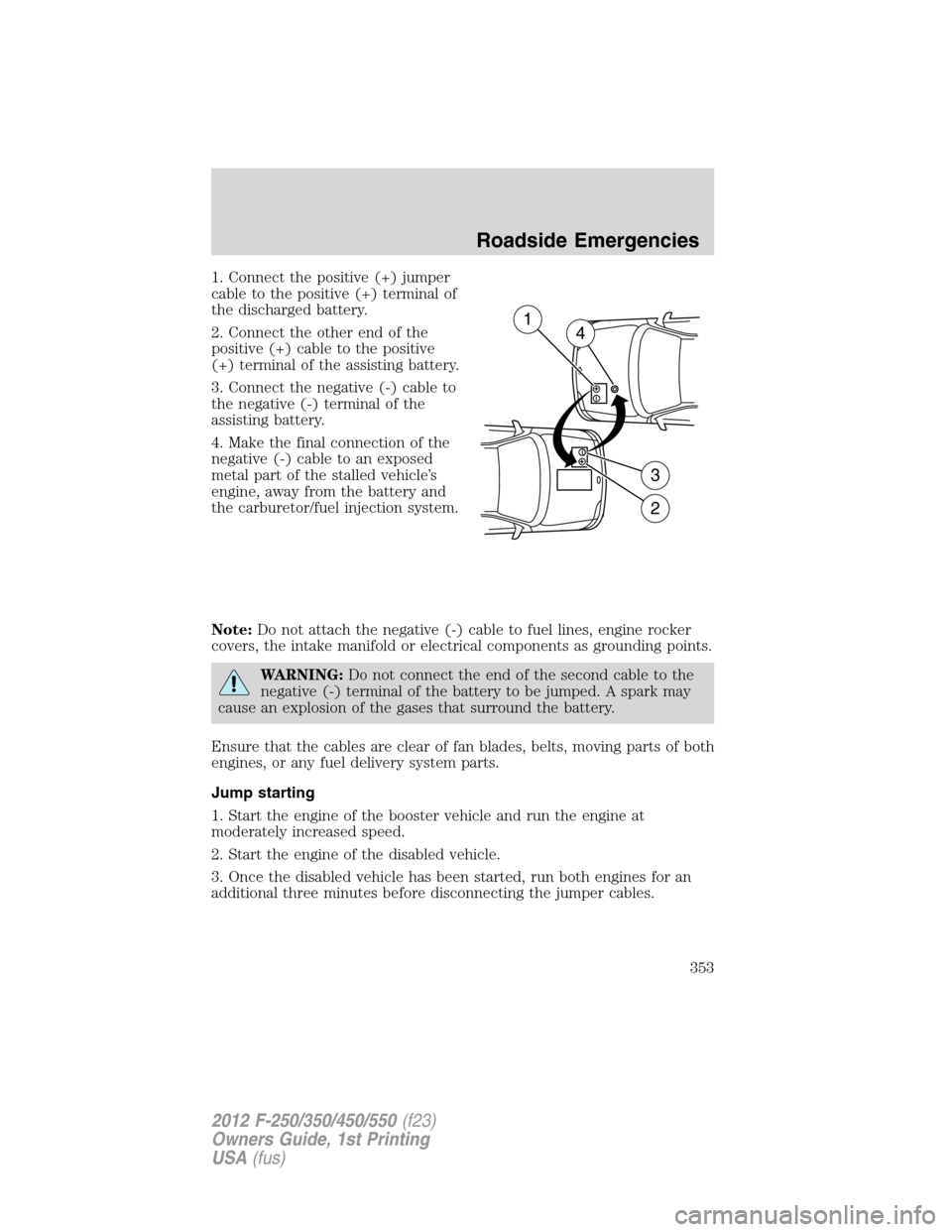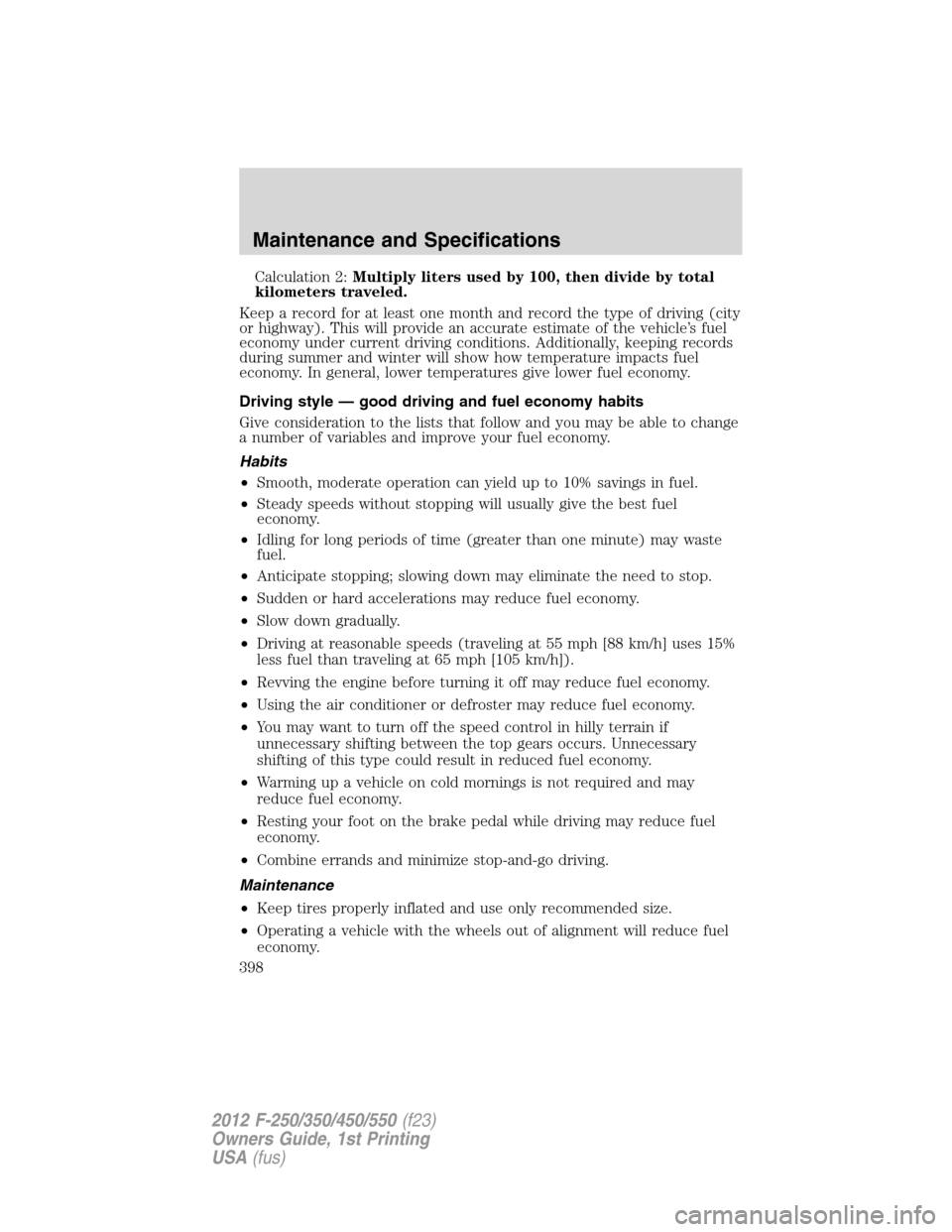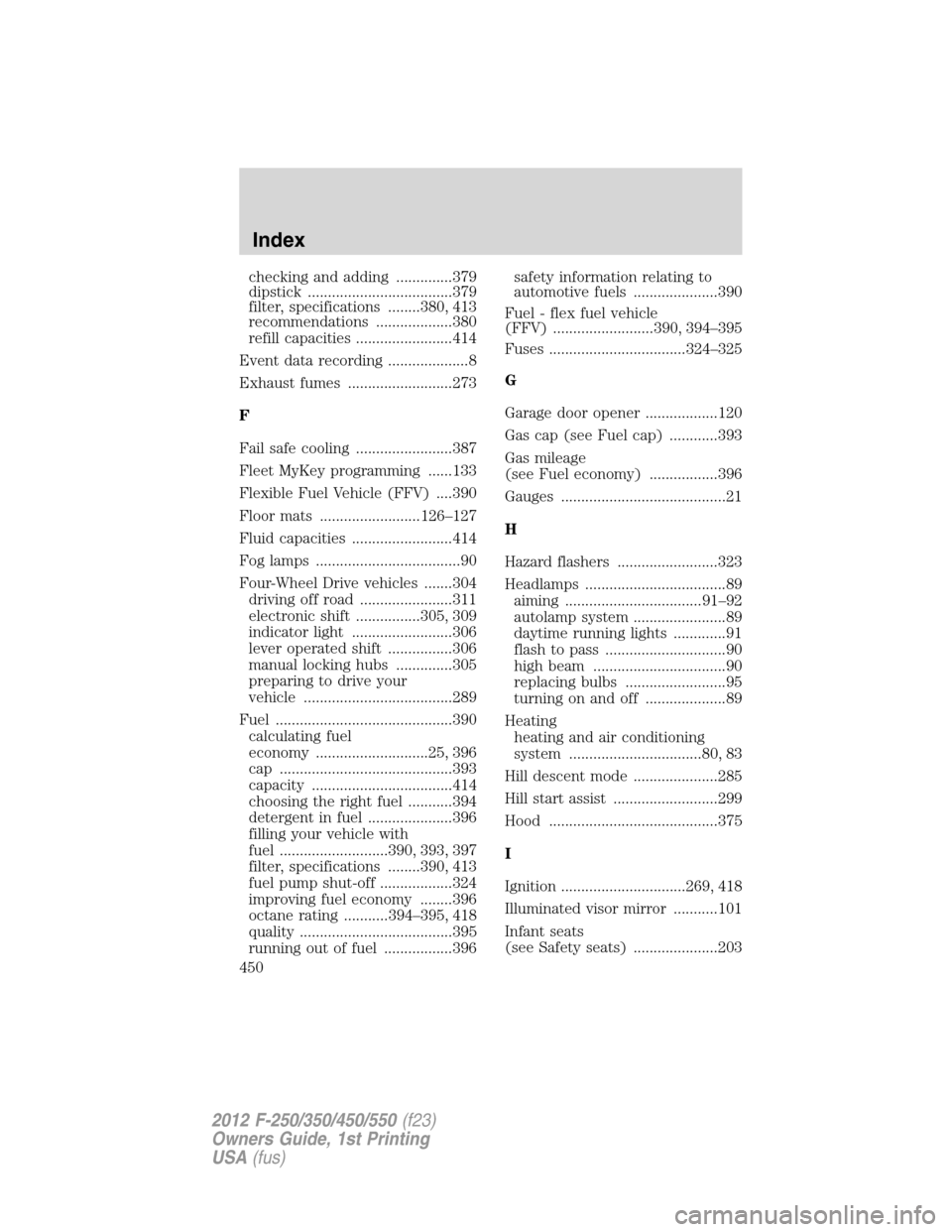2012 FORD SUPER DUTY ECO mode
[x] Cancel search: ECO modePage 336 of 454

•Ground clearance and parking at curbs
•Winter weather driving capability
•Wet weather driving capability
It is not recommended that the vehicle be operated in 4WD modes with
a temporary emergency spare tire. If 4WD operation is necessary, do not
operate above speeds of 10 mph (16 km/h) or for distances above
50 miles (80 km).
3.Full-size dissimilar spare without label on wheel
When driving with the full-size dissimilar spare tire/wheel,do not:
•Exceed 70 mph (113 km/h)
•Use more than one dissimilar spare tire/wheel at a time
•Use commercial car washing equipment
•Use snow chains on the end of the vehicle with the dissimilar spare
tire/wheel
The usage of a full-size dissimilar spare tire/wheel can lead to
impairment of the following:
•Handling, stability and braking performance
•Comfort and noise
•Ground clearance and parking at curbs
•Winter weather driving capability
•Wet weather driving capability
•All-Wheel driving capability (if applicable)
•Load leveling adjustment (if applicable)
When driving with the full-size dissimilar spare tire/wheel additional
caution should be given to:
•Towing a trailer
•Driving vehicles equipped with a camper body
•Driving vehicles with a load on the cargo rack
Drive cautiously when using a full-size dissimilar spare tire/wheel and
seek service as soon as possible.
Roadside Emergencies
336
2012 F-250/350/450/550(f23)
Owners Guide, 1st Printing
USA(fus)
Page 353 of 454

1. Connect the positive (+) jumper
cable to the positive (+) terminal of
the discharged battery.
2. Connect the other end of the
positive (+) cable to the positive
(+) terminal of the assisting battery.
3. Connect the negative (-) cable to
the negative (-) terminal of the
assisting battery.
4. Make the final connection of the
negative (-) cable to an exposed
metal part of the stalled vehicle’s
engine, away from the battery and
the carburetor/fuel injection system.
Note:Do not attach the negative (-) cable to fuel lines, engine rocker
covers, the intake manifold or electrical components as grounding points.
WARNING:Do not connect the end of the second cable to the
negative (-) terminal of the battery to be jumped. A spark may
cause an explosion of the gases that surround the battery.
Ensure that the cables are clear of fan blades, belts, moving parts of both
engines, or any fuel delivery system parts.
Jump starting
1. Start the engine of the booster vehicle and run the engine at
moderately increased speed.
2. Start the engine of the disabled vehicle.
3. Once the disabled vehicle has been started, run both engines for an
additional three minutes before disconnecting the jumper cables.
+–
+–
2
3
14
Roadside Emergencies
353
2012 F-250/350/450/550(f23)
Owners Guide, 1st Printing
USA(fus)
Page 398 of 454

Calculation 2:Multiply liters used by 100, then divide by total
kilometers traveled.
Keep a record for at least one month and record the type of driving (city
or highway). This will provide an accurate estimate of the vehicle’s fuel
economy under current driving conditions. Additionally, keeping records
during summer and winter will show how temperature impacts fuel
economy. In general, lower temperatures give lower fuel economy.
Driving style — good driving and fuel economy habits
Give consideration to the lists that follow and you may be able to change
a number of variables and improve your fuel economy.
Habits
•Smooth, moderate operation can yield up to 10% savings in fuel.
•Steady speeds without stopping will usually give the best fuel
economy.
•Idling for long periods of time (greater than one minute) may waste
fuel.
•Anticipate stopping; slowing down may eliminate the need to stop.
•Sudden or hard accelerations may reduce fuel economy.
•Slow down gradually.
•Driving at reasonable speeds (traveling at 55 mph [88 km/h] uses 15%
less fuel than traveling at 65 mph [105 km/h]).
•Revving the engine before turning it off may reduce fuel economy.
•Using the air conditioner or defroster may reduce fuel economy.
•You may want to turn off the speed control in hilly terrain if
unnecessary shifting between the top gears occurs. Unnecessary
shifting of this type could result in reduced fuel economy.
•Warming up a vehicle on cold mornings is not required and may
reduce fuel economy.
•Resting your foot on the brake pedal while driving may reduce fuel
economy.
•Combine errands and minimize stop-and-go driving.
Maintenance
•Keep tires properly inflated and use only recommended size.
•Operating a vehicle with the wheels out of alignment will reduce fuel
economy.
Maintenance and Specifications
398
2012 F-250/350/450/550(f23)
Owners Guide, 1st Printing
USA(fus)
Page 423 of 454

Peace of mind
•Keyless entry keypad•Back up alarm*
•Remote start•Cable lock*
•Vehicle security systems•Bed hooks*
•Wheel locks•Tool/Cargo boxes*
•Protective seat covers*
•Bumper and hitch mounted parking sensors*
Not all accessories are available for all models.
*Ford Licensed Accessories (FLA) are warranted by the accessory
manufacturer’s warranty. Ford Licensed Accessories are fully designed
and developed by the accessory manufacturer and have not been
designed or tested to Ford Motor Company engineering requirements.
Contact your Ford dealer for details regarding the manufacturer’s limited
warranty and/or a copy of the FLA product limited warranty offered by
the accessory manufacturer.
For maximum vehicle performance, keep the following information in
mind when adding accessories or equipment to your vehicle:
•When adding accessories, equipment, passengers and luggage to your
vehicle, do not exceed the total weight capacity of the vehicle or of
the front or rear axle (GVWR or GAWR as indicated on the Safety
Compliance Certification Label). Consult your authorized dealer for
specific weight information.
•The Federal Communications Commission (FCC) and Canadian Radio
Telecommunications Commission (CRTC) regulate the use of mobile
communications systems — such as two-way radios, telephones and
theft alarms - that are equipped with radio transmitters. Any such
equipment installed in your vehicle should comply with FCC or CRTC
regulations and should be installed only by your authorized dealer.
•Mobile communications systems may harm the operation of your
vehicle, particularly if they are not properly designed for automotive
use.
•To avoid interference with other vehicle functions, such as anti-lock
braking systems, amateur radio users who install radios and antennas
onto their vehicle should not locate the Amateur Radio Antennas in
the area of the driver’s side hood.
•Any non-Ford custom electrical or electronic accessories or
components that are added to the vehicle by the authorized dealer or
the owner may adversely affect battery performance and durability.
Accessories
423
2012 F-250/350/450/550(f23)
Owners Guide, 1st Printing
USA(fus)
Page 450 of 454

checking and adding ..............379
dipstick ....................................379
filter, specifications ........380, 413
recommendations ...................380
refill capacities ........................414
Event data recording ....................8
Exhaust fumes ..........................273
F
Fail safe cooling ........................387
Fleet MyKey programming ......133
Flexible Fuel Vehicle (FFV) ....390
Floor mats .........................126–127
Fluid capacities .........................414
Fog lamps ....................................90
Four-Wheel Drive vehicles .......304
driving off road .......................311
electronic shift ................305, 309
indicator light .........................306
lever operated shift ................306
manual locking hubs ..............305
preparing to drive your
vehicle .....................................289
Fuel ............................................390
calculating fuel
economy ............................25, 396
cap ...........................................393
capacity ...................................414
choosing the right fuel ...........394
detergent in fuel .....................396
filling your vehicle with
fuel ...........................390, 393, 397
filter, specifications ........390, 413
fuel pump shut-off ..................324
improving fuel economy ........396
octane rating ...........394–395, 418
quality ......................................395
running out of fuel .................396safety information relating to
automotive fuels .....................390
Fuel - flex fuel vehicle
(FFV) .........................390, 394–395
Fuses ..................................324–325
G
Garage door opener ..................120
Gas cap (see Fuel cap) ............393
Gas mileage
(see Fuel economy) .................396
Gauges .........................................21
H
Hazard flashers .........................323
Headlamps ...................................89
aiming ..................................91–92
autolamp system .......................89
daytime running lights .............91
flash to pass ..............................90
high beam .................................90
replacing bulbs .........................95
turning on and off ....................89
Heating
heating and air conditioning
system .................................80, 83
Hill descent mode .....................285
Hill start assist ..........................299
Hood ..........................................375
I
Ignition ...............................269, 418
Illuminated visor mirror ...........101
Infant seats
(see Safety seats) .....................203
Index
450
2012 F-250/350/450/550(f23)
Owners Guide, 1st Printing
USA(fus)